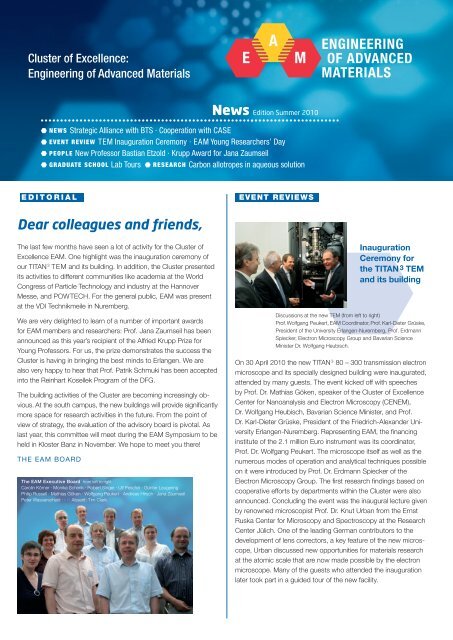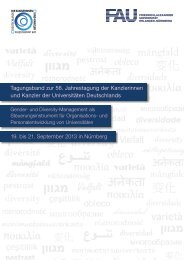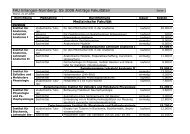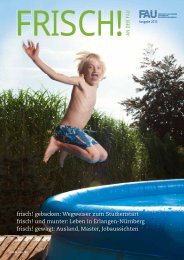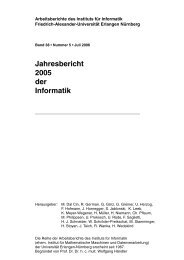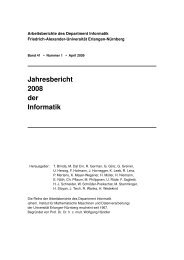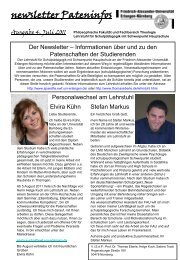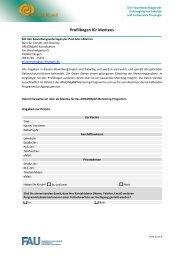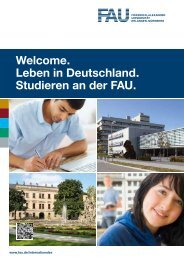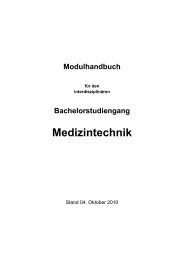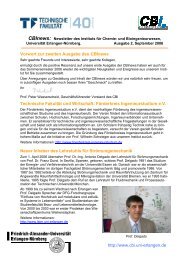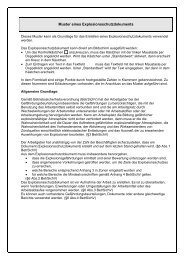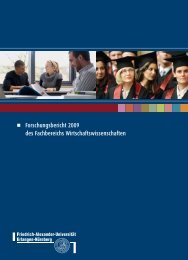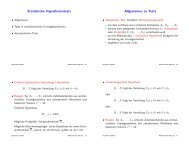Dear colleagues and friends,
Dear colleagues and friends,
Dear colleagues and friends,
You also want an ePaper? Increase the reach of your titles
YUMPU automatically turns print PDFs into web optimized ePapers that Google loves.
Cluster of Excellence:<br />
Engineering of Advanced Materials<br />
News Edition Summer 2010<br />
News Strategic Alliance with BTS · Cooperation with CASE<br />
event review TEM Inauguration Ceremony · EAM Young Researchers’ Day<br />
people New Professor Bastian Etzold · Krupp Award for Jana Zaumseil<br />
Graduate School Lab Tours Research Carbon allotropes in aqueous solution<br />
E d i t o r i a l<br />
event reviews<br />
<strong>Dear</strong> <strong>colleagues</strong> <strong>and</strong> <strong>friends</strong>,<br />
The last few months have seen a lot of activity for the Cluster of<br />
Excellence EAM. One highlight was the inauguration ceremony of<br />
our TITAN 3 TEM <strong>and</strong> its building. In addition, the Cluster presented<br />
its activities to different communities like academia at the World<br />
Congress of Particle Technology <strong>and</strong> industry at the Hannover<br />
Messe, <strong>and</strong> POWTECH. For the general public, EAM was present<br />
at the VDI Technikmeile in Nuremberg.<br />
We are very delighted to learn of a number of important awards<br />
for EAM members <strong>and</strong> researchers: Prof. Jana Zaumseil has been<br />
announced as this year’s recipient of the Alfried Krupp Prize for<br />
Young Professors. For us, the prize demonstrates the success the<br />
Cluster is having in bringing the best minds to Erlangen. We are<br />
also very happy to hear that Prof. Patrik Schmuki has been accepted<br />
into the Reinhart Kosellek Program of the DFG.<br />
The building activities of the Cluster are becoming increasingly obvious.<br />
At the south campus, the new buildings will provide signi ficantly<br />
more space for research activities in the future. From the point of<br />
view of strategy, the evaluation of the advisory board is pivotal. As<br />
last year, this committee will meet during the EAM Symposium to be<br />
held in Kloster Banz in November. We hope to meet you there!<br />
The EAM Board<br />
The EAM Executive Board from left to right<br />
Carolin Körner · Monika Schenk · Robert Singer · Ulf Peschel · Günter Leugering<br />
Philip Russell · Mathias Göken · Wolfgang Peukert · Andreas Hirsch · Jana Zaumseil<br />
Peter Wasserscheid · · · · Absent: Tim Clark<br />
Inauguration<br />
Ceremony for<br />
the Titan 3 TEM<br />
<strong>and</strong> its building<br />
Discussions at the new TEM (from left to right)<br />
Prof. Wolfgang Peukert, EAM Coordinator, Prof. Karl-Dieter Grüske,<br />
President of the Uni versity Erlangen-Nuremberg, Prof. Erdmann<br />
Spiecker, Electron Microscopy Group <strong>and</strong> Bavarian Science<br />
Minister Dr. Wolfgang Heubisch.<br />
On 30 April 2010 the new TITAN 3 80 – 300 transmission electron<br />
microscope <strong>and</strong> its specially designed building were inaugurated,<br />
attended by many guests. The event kicked off with speeches<br />
by Prof. Dr. Mathias Göken, speaker of the Cluster of Excellence<br />
Center for Nanoanalysis <strong>and</strong> Electron Microscopy (CENEM),<br />
Dr. Wolfgang Heubisch, Bavarian Science Minister, <strong>and</strong> Prof.<br />
Dr. Karl-Dieter Grüske, President of the Friedrich-Alex<strong>and</strong>er Uni <br />
ver sity Erlangen-Nuremberg. Representing EAM, the financing<br />
institute of the 2.1 million Euro instrument was its coordinator,<br />
Prof. Dr. Wolfgang Peukert. The microscope itself as well as the<br />
numerous modes of operation <strong>and</strong> analytical techniques possible<br />
on it were introduced by Prof. Dr. Erdmann Spiecker of the<br />
Electron Microscopy Group. The first research findings based on<br />
cooperative efforts by departments within the Cluster were also<br />
announced. Concluding the event was the inaugural lecture given<br />
by renowned microscopist Prof. Dr. Knut Urban from the Ernst<br />
Ruska Center for Microscopy <strong>and</strong> Spectroscopy at the Research<br />
Center Jülich. One of the leading German contributors to the<br />
development of lens correctors, a key feature of the new microscope,<br />
Urban discussed new opportunities for materials research<br />
at the atomic scale that are now made possible by the electron<br />
microscope. Many of the guests who attended the inauguration<br />
later took part in a guided tour of the new facility.
2 Cluster of Excellence News Edition Summer 2010<br />
Top meeting-place for particle technology<br />
From 26 – 29 April the particle technology community met in<br />
Nurem berg for the World Congress on Particle Technology (WCPT6).<br />
The conference began with a plenary lecture entitled “Particle Technology<br />
for Materials Science” given by Prof. Wolfgang Peukert. His<br />
was not the only contri bu tion from Erlangen, however: An impressive<br />
total of twenty-six talks <strong>and</strong> fifteen posters were contributed by<br />
researchers from the University Erlangen-Nuremberg.<br />
This year, the WCPT was combined with POWTECH 2010, the international<br />
trade fair for mechanical processing technologies <strong>and</strong> instrumentation.<br />
The merging of these two events proved to be very<br />
successful, as it enabled representa tives from academia <strong>and</strong> indus try<br />
to share experiences from the re search lab <strong>and</strong> the marketplace. To<br />
showcase the Cluster’s pre sence in fundamental <strong>and</strong> applied research,<br />
activities in particle tech nology, catalysis, modeling <strong>and</strong> simulation, <strong>and</strong><br />
trans mission elec tron microscopy were displayed at its 60m 2 st<strong>and</strong>.<br />
EAM saw its first colloquium organized by young researchers<br />
from all research areas of the Cluster. Under the motto “Telling<br />
the story of interdisciplinarity”, many junior <strong>and</strong> several senior<br />
EAM researchers met on 19 July 2010 in the br<strong>and</strong> new Bernhard-<br />
Ilschner audi torium in the Materials Science department. Five<br />
t<strong>and</strong>em talks given by PhD students <strong>and</strong> postdocs presented<br />
multifaceted projects <strong>and</strong> reported on latest results. Three renowned<br />
scientists from national <strong>and</strong> international research institutions<br />
complemented the program with their insights into<br />
multidisciplinary research. Dr. Anders Riisager from the CASE<br />
(Catalysis for Sustainable Energy) cluster in Lyngby/Denmark,<br />
Dr. Chaitanya Ullal from MPI for Biophysical Chemistry in Göttingen,<br />
<strong>and</strong> Dr. Bettina Frohnapfel from CSI (Center of Smart<br />
Inter faces) Darmstadt kindly accepted the invitation of the orga -<br />
ni zing team to deliver a keynote lecture.<br />
The Young Researchers’ Day was also a very appropriate occasion<br />
to sign the new collaboration agreement between the CASE<br />
cluster <strong>and</strong> EAM (see page 7). Special mention was also made<br />
of the demonstrators being developed to support the Cluster’s<br />
second funding round proposal. Following an introduction by<br />
Cluster coordinator Prof. Wolfgang Peukert underlining the<br />
importance of the demonstrators, each research area showed<br />
the status of its demonstrator in posters supported with h<strong>and</strong>son<br />
exhibits. In parallel, many other EAM projects presented their<br />
results during two poster sessions.<br />
The EAM summer party concluded this successful day. The warm<br />
weather, a delicious barbecue, <strong>and</strong> relaxed music created the right<br />
atmosphere to continue the discussions started during the day.<br />
New Building Blocks for Electronic Components<br />
EAM exhibited its research activities in printable electronics at the<br />
Bayern Innovativ joint st<strong>and</strong> at the Hannover Messe 2010 from<br />
19 – 23 April 2010. EAM presented three different examples of<br />
these components in the Research & Tech no logy hall: organic solar<br />
cells, thin film transistors, <strong>and</strong> flexible sensors.<br />
EAM at the 4th VDI Technikmeile in Nuremberg<br />
On 23 <strong>and</strong> 24 July the public strolling on Nuremberg’s pedestrian<br />
zone was given a h<strong>and</strong>s-on demonstration of the fascinating world<br />
of nanotechnology at the 4th VDI Technikmeile. Contributing a joint<br />
st<strong>and</strong> were four Bavarian science <strong>and</strong> technology institutions: the<br />
Bavarian Cluster Nanotechnology, the Bayreuth Center for Colloids<br />
<strong>and</strong> Interfaces (BZKG), Ceramic Composites e. V. <strong>and</strong> EAM.<br />
EAM exhibits demonstrated how scientists at EAM design <strong>and</strong><br />
customize molecules <strong>and</strong> nanoparticles in order to develop materials<br />
<strong>and</strong> surfaces with new mechanical, optical, catalytic <strong>and</strong> electronic<br />
properties. As fuels <strong>and</strong> energy efficiency was the main theme of<br />
the VDI Technikmeile 2010, EAM showcased its organic solar cell<br />
activities as well as cellular materials for lightweight components.
3 Cluster of Excellence News Edition Summer 2010<br />
graduate school<br />
Graduate School Lab Tours<br />
Frank Nachtrab demonstrating nondestructive testing<br />
with a 3D computer tomograph at Fraunhofer EZRT<br />
Since the institutions<br />
participating in EAM<br />
are rather distributed<br />
across the cities of<br />
Erlangen <strong>and</strong> Fürth,<br />
it is difficult for researchers<br />
to have a good<br />
overview of the resear<br />
ch activities taking<br />
place <strong>and</strong> the facili <br />
ties available. Therefore,<br />
at the suggestion<br />
of the EAM doctoral re searchers, the graduate school has now<br />
begun bi-weekly tours which will take in all EAM-participating ins titutions.<br />
In the summer semester 2010, graduate school members<br />
<strong>and</strong> EAM researchers participated in tours of the Fraunhofer EZRT<br />
<strong>and</strong> the Central Ins titute for Advanced Materials <strong>and</strong> Processes<br />
(ZMP) in Fürth, Prof. Spiecker’s Electron Microscopy Group – in cluding<br />
the new Titan³ 80–300 TEM – the Max Planck Institute for the<br />
Science of Light, <strong>and</strong> the Institute for Multiscale Modeling of Particulate<br />
Systems.<br />
SWCNT based technological progress which has so far been restricted<br />
by the polydispersity of the as-produced material. In this<br />
regard, the designed surfactants are highly promising c<strong>and</strong>idates,<br />
as the perylene-based surfactants possess an enhanced affinity<br />
towards smaller diameter SWCNTs 1 , while the pyrene derivatives 3<br />
show an opposite trend. Thus both studies present a significant<br />
step forward in aiding SWCNT sorting.<br />
Furthermore, this concept has been extended towards an efficient<br />
production sequence for graphene 2 , starting from graphite by<br />
simply sonicating the bulk material in the presence of a perylenebased<br />
surfactant. This approach provides access to single <strong>and</strong> few<br />
layer graphene without the introduction of defects, i.e. leaving the<br />
sp 2 -hybridization of the aromatic carbon sheets intact. This result<br />
could pave the way to an inexpensive mass production of graphene<br />
allowing the analysis <strong>and</strong> manipulation of exfoliated graphene flakes<br />
in large quantities.<br />
SWCNT <strong>and</strong> graphene research could recently be partly unified in<br />
their characterization by the visualization of the nanoscaled objects<br />
by optical microscopy on opaque bilayered substrates – a technique<br />
that has been established for graphene characterization, but has<br />
thus far not been reported for the 1D SWCNTs. This observation<br />
will drive SWCNT characterization a significant step forward <strong>and</strong><br />
has thus been featured as cover article in Small. 4<br />
The lab tours were usually conducted by doctoral researchers<br />
from the respective host institution, who presented an overview<br />
of its research topics followed by a guided tour through selected<br />
labs. Of special interest were the experimental equipment <strong>and</strong> the<br />
theoretical expertise available to support other EAM pro jects. The<br />
tours have proven to trigger intense discussions about potential<br />
new collaborations, <strong>and</strong> often concluded in a nearby pub or beer<br />
garden. In the coming winter semester the institutes in the Chemistry<br />
<strong>and</strong> Chemical Engineering departments will be the focus<br />
of the lab tours. Suggestions for other lab tour venues are always<br />
welcome.<br />
research<br />
Solubilization of carbon allotropes<br />
in aqueous solution<br />
Responding to a growing interest to enhance the processability<br />
of new carbon allotropes, four papers from the Hirsch group have<br />
recently been featured as cover pictures in Chemical Communications<br />
1 , Advanced Materials 2 , Chemistry – A European Journal 3<br />
<strong>and</strong> Small 4 . The studies have been concerned with the solubilization<br />
<strong>and</strong> characterization of intrinsically insoluble single-walled carbon<br />
nanotubes (SWCNTs) <strong>and</strong> graphene in aqueous solutions by<br />
noncovalent interactions with designed surfactants, e.g. amphiphilic<br />
molecules with perylene or pyrene moieties as anchoring<br />
group also synthesized in the Hirsch group.<br />
In the case of SWCNTs, the main target is not only the solubilization<br />
of the carbon allotrope, but also the separation of SWCNTs of different<br />
diameters or electronic type being of uttermost importance for<br />
References<br />
1 Fractioning HiPco <strong>and</strong> CoMoCAT SWCNTs via Density Gradient Ultracentrifu <br />
gation by the Aid of a Novel Perylene Bisimide Derivative Surfactant, C. Backes,<br />
et al., Chem. Commun. 19, 2643 – 2645, doi:10.1039/b818141a (2009).<br />
2 Soluble Graphene: Generation of Aqueous Graphene Solutions Aided by a<br />
Perylenebisimide-Based Bolaamphiphile, J. M. Englert, et al., Adv. Mater. 21, 4265<br />
– 4269, doi:10.1002/adma.200901578 (2010).<br />
3 Dispersion of HiPco <strong>and</strong> CoMoCAT Single-Walled Nanotubes (SWNTs) by Water<br />
Soluble Pyrene Derivatives - Depletion of Small Diameter SWNTs, C. Backes,<br />
et al., Chem. Europ. J. 16, 3314 – 3317, doi:10.1002/chem.200903420 (2010).<br />
4 Optical visualization of carbon nanotubes – a unifying linkage between micros <br />
copic <strong>and</strong> spectroscopic characterization techniques, C. Backes, et al., Small 18,<br />
doi:10.1002/smll.201001019 (2010).
4 Cluster of Excellence News Edition Summer 2010<br />
What are your current research projects <strong>and</strong> in which direction<br />
do you plan to develop your research in the coming years?<br />
My current research is about the synthesis of structured nanoporous<br />
carbon materials. Self-supporting highly nanoporous car bon<br />
foams were successfully prepared via the chlorination of carbides.<br />
The kinetics of the gas/solid reaction for the synthesis is being<br />
studied in detail at the moment. In the future, the application of<br />
these structured carbons as catalyst supports will be more in the<br />
focus of the research. Recently we have successfully developed<br />
novel techniques to add locally-varied mesopores to the carbon.<br />
This will be studied more in-depth in the future.<br />
What are your projects <strong>and</strong> plans regarding cooperations with<br />
other cluster members?<br />
Several cooperations with other cluster members have already<br />
started. Together with Prof. Singer <strong>and</strong> Dr. Körner the coating of<br />
‘electron beam printed’ titanium structures with nanoporous<br />
carbons <strong>and</strong> the use of them as advanced catalyst supports is being<br />
studied. Together with Prof. Greil <strong>and</strong> Dr. Fey carbide structures<br />
with channels ranging from the scale of mm to µm are studied for<br />
their conversion to carbons, which would extend the hierarchical<br />
structure down to the nanoscale. Together with Prof. Spiecker the<br />
question of homogeneous active metal distribution within the<br />
carbon is studied with the new TEM. Prof. Schwieger’s <strong>and</strong> my<br />
group recently started a cooperation on the utilization of regularly<br />
structured oxides for carbon nanocasting.<br />
Which benefits do you experience from the cluster’s activities<br />
<strong>and</strong> the cooperations within EAM ?<br />
The cluster is a unique chance to perform materials research within<br />
a special environment. The cooperations already started show the<br />
great potential of this. Fast access to world class analytical techpeople<br />
New Junior<br />
Professor<br />
Bastian Etzold<br />
Bastian Etzold studied<br />
Chemical Engineering in<br />
Erlangen <strong>and</strong> Business<br />
Administration in Hagen.<br />
He received his doctoral<br />
degree in Bayreuth summa<br />
cum laude. Since April ’08<br />
Bastian Etzold has been<br />
working in Erlangen at the<br />
Department of Chemical <strong>and</strong> Bioengineering. The focus of his group<br />
at the Chair for Chemical Reaction Engineering (Prof. Dr. Peter<br />
Wasserscheid) is the application of gas/solid reactions for the synthesis<br />
of novel structured catalytic materials <strong>and</strong> adsorbents. In<br />
December 2009 he was appointed as Junior Professor for Catalytic<br />
Materials within the Rising Star program of EAM.<br />
niques or materials prepared by <strong>colleagues</strong> are the direct ‘visible’<br />
advantages. But even more important is the inspiring atmosphere,<br />
the broad-based knowhow of the <strong>colleagues</strong> bridging all of the<br />
natural <strong>and</strong> engineering sciences <strong>and</strong> the fruitful discussions<br />
which generate new ideas within the cluster. This really makes the<br />
difference <strong>and</strong> gives me the chance to perform excellent research.<br />
You coordinate the ‘School + Science’ program initiated by<br />
the School of Engineering <strong>and</strong> the Department of Chemical<br />
<strong>and</strong> Bioengineering. What are the goals of this activity?<br />
The main goal is to establish an open dialogue between the<br />
secondary schools <strong>and</strong> the university, based on the new ‘W&P<br />
seminars’ for years 11 <strong>and</strong> 12. Without great bureaucracy the<br />
pupils, teachers <strong>and</strong> employees of the university liaise about<br />
present <strong>and</strong> future planned seminar topics. Areas of common<br />
interest <strong>and</strong> possible interaction are thus being identified in<br />
an uncomplicated manner.<br />
Interview with Bastian Etzold<br />
Professor<br />
Jana Zaumseil<br />
receives<br />
Alfried Krupp<br />
Prize<br />
Prof. Dr. Jana Zaumseil, Professor for Nanoelectronics at the Cluster<br />
of Excellence Engineering of Advanced Materials (EAM) has been<br />
announced as this year’s recipient of the Alfried Krupp Prize for<br />
Young Professors by the Alfried Krupp von Bohlen und Halbach<br />
Foundation. The prize comes with a grant of one million Euros to<br />
be paid over five years.<br />
“We are very happy about this award for Jana Zaumseil”, states<br />
Prof. Wolfgang Peukert. “The prize demonstrates the success the<br />
Cluster is having in bringing the best minds to Erlangen. Jana Zaum <br />
seil’s expertise <strong>and</strong> the additional funding will bring further impetus<br />
for successful future research activities in nanoelectronics.” Jana<br />
Zaumseil’s work on cutting-edge topics in organic electronics took<br />
shape during her doctoral <strong>and</strong> postdoctoral studies in the UK <strong>and</strong><br />
USA. In Erlangen her primary area of research is the synthesis <strong>and</strong><br />
characterization of novel nanostructures that, depending on their<br />
dimensions, absorb <strong>and</strong> emit light of specific wavelengths. Her<br />
re search aims to gain an underst<strong>and</strong>ing of the ways in which these<br />
processes can be influenced <strong>and</strong> controlled for use in optoelec tronic<br />
components. She joined the Cluster in October 2009 as awardee<br />
of the EAM Excellence in Engineering Award.
5 Cluster of Excellence News Edition Summer 2010<br />
obituary<br />
1.25 Million Euro<br />
Koselleck-grant<br />
for EAM Member<br />
Professor<br />
Patrik Schmuki<br />
Prof. Dr. Patrik Schmuki,<br />
chair of Corrosion <strong>and</strong><br />
Surface Technology at the<br />
Department of Materials<br />
Sciences has been accepted<br />
into the Reinhart Kosellek<br />
Program of the German<br />
Research Foun da tion, which has been established to promote<br />
innovative <strong>and</strong> cutting edge research. Patrick Schmuki will receive<br />
the highest awarded grant sum of 1.25 Million Euros, to be used<br />
over the next five years. The funds will support his ongoing <strong>and</strong><br />
highly successful research in surface technology, in particular to<br />
develop an entirely new gene ration of titanium dioxide nanotubes.<br />
The tube walls can be modi fied precisely on a nanometer scale,<br />
thereby fundamentally impro ving their properties <strong>and</strong> exp<strong>and</strong>ing<br />
the range of possible appli ca tions.<br />
The long-term goals of his work are to:<br />
• produce hydrogen economically through the use of solar energy<br />
• increase the efficiency of dye-sensitized solar cells<br />
• develop bifunctional medical implants which display particular<br />
characteristics (e.g. bactericidal effect) at precisely defined locations.<br />
awards<br />
PRACE Award 2010 for EAM Member Professor Ulrich Rüde<br />
PRACE (Partnership for Advanced Computing in Europe) awarded a prize for the<br />
outst<strong>and</strong>ing scientific paper “Massively Parallel Granular Flow Simulations with<br />
Non-Spherical Particles” submitted by Klaus Iglberger, M. Sc. <strong>and</strong> Prof. Dr. Ulrich<br />
Rüde (research area A3). The paper addressed successfully the issue of how to<br />
simulate realistically flows of granular materials, when particles of different shapes<br />
are moving in a complex en vironment. It introduces a new algorithm that shows<br />
an excellent scalability on a very high number of cores, making very large simulations<br />
possible.<br />
MRS Poster Award for EAM researcher Michael Novak Michael<br />
Novak (research area B) received the prestigious MRS Poster Award (<strong>and</strong> $ 500<br />
prize) at the Materials Research Society Spring Meeting 2010 in San Fran cisco.<br />
The poster entitled “The morphology of integrated self-assembled monolayers<br />
<strong>and</strong> their impact on devices – A computational <strong>and</strong> experimen tal approach” was<br />
submitted by Michael Novak, Christof Jäger, Henning Kropp, Timothy Clark <strong>and</strong><br />
Marcus Halik <strong>and</strong> was voted ahead of more than 400 other entries.<br />
Best Poster Award for EAM researcher Ning Da Ning Da (research<br />
area C) won the Best Poster Award (<strong>and</strong> 100 Euros prize) at the 17th Inter national<br />
Conference on Non-Oxide <strong>and</strong> Novel Optical Glasses (ISNOG) in Ningbo, China for<br />
the poster “Soft oxide <strong>and</strong> non-oxide glass-filled capillary waveguides <strong>and</strong> photonic<br />
crystal fibers” co-authored with Markus Schmidt, Nicolai Granzow, Philip Russell<br />
<strong>and</strong> Lothar Wondraczek. The ISNOG, which is held every two years, is the largest<br />
<strong>and</strong> internationally most recognized of all conferences on this topic.<br />
Professor<br />
Isaac Goldhirsch<br />
Prof. Isaac Goldhirsch, distinguished<br />
Israeli scholar<br />
<strong>and</strong> scientist, passed away<br />
suddenly on 29 April 2010<br />
while visiting the University<br />
of Erlangen-Nuremberg.<br />
Professor Goldhirsch, 60,<br />
was chair of Rheological<br />
Flows at the Tel-Aviv University’s<br />
School of Mechani cal<br />
Engineering <strong>and</strong> was considered to be the leading authority in the<br />
field of granular matter science. In EAM he served as a member of<br />
the external advisory board <strong>and</strong> many will remember the fascinating<br />
<strong>and</strong> well-received talk he gave during the EAM Symposium in<br />
Wildbad Kreuth in November 2009.<br />
Born in Romania in 1949 Goldhirsch embarked on an academic<br />
career that spanned a number of disciplines <strong>and</strong> several continents.<br />
As a young scientist he earned distinctions such as the Kennedy<br />
Prize from the Weizmann Institute’s Feinberg Graduate School <strong>and</strong><br />
a postdoctoral appointment with Irwin Oppenheim at the Massachusetts<br />
Institute of Technology.<br />
Renowned for his research in granular physics, Goldhirsch is<br />
credited with laying the theoretical <strong>and</strong> methodological foundation<br />
for its study. His contributions in the fields of statistical mechanics,<br />
fluid mechanics, solid state physics <strong>and</strong> applied mathematics<br />
helped promote <strong>and</strong> develop an international interdisciplinary<br />
scientific community. Fluent in eight languages, Goldhirsch served<br />
as editor of the Journal of Fluid Mechanics <strong>and</strong> editor-in-chief<br />
of Granular Matter <strong>and</strong> was on the editorial board of the Journal<br />
of Scientific Computing. He was an active member of the General<br />
Assembly for the International Union of Theoretical <strong>and</strong> Applied<br />
Mechanics (IUTAM). We extend our condolences to his family as<br />
we share the loss of a good friend <strong>and</strong> outst<strong>and</strong>ing scientist.<br />
Welcome<br />
to the Cluster!<br />
New EAM Members<br />
Dr. Silke Christiansen<br />
Head of Scientific Service Group<br />
Photonic Nanostructures, Max Planck Institute<br />
for the Science of Light<br />
Prof. Dr. Rainer Fink<br />
Professor for Physical Chemistry<br />
Prof. Dr. Andreas Magerl<br />
Chair for Crystallography <strong>and</strong> Structural Physics
6 Cluster of Excellence News Edition Summer 2010<br />
news<br />
Strategic<br />
Alliance<br />
with Bayer<br />
Technology<br />
Services<br />
Dr. Helmut Mothes, Bayer Technology<br />
Services GmbH, <strong>and</strong><br />
Prof. Wolfgang Peukert, EAM,<br />
signing the cooperation agreement<br />
Bayer Technology Services<br />
EAM illustrates process chain in printable<br />
electronics at exhibition in Mannheim<br />
A new exhibition called “Nano! Use <strong>and</strong> Vision of a New Technology”<br />
at the Technoseum in Mannheim <strong>and</strong> running until 3 October<br />
2010 is bringing visitors face to face with the nanoworld <strong>and</strong> atomic<br />
structures. The 900 m 2 exhibition presents the beginnings, scien <br />
ti fic principles <strong>and</strong> applications of nanotechnology, as well as<br />
discus sions of the possible risks associated with it.<br />
Strategic alliances are a crucial element of EAM’s technology<br />
transfer program. The cooperation agreement between EAM <strong>and</strong><br />
Bayer Technology Services GmbH (BTS) combines fundamental<br />
research with industrial development. The two EAM-BTS projects<br />
focus on basic research to develop new production technologies.<br />
The larger of the two projects examines the key materials <strong>and</strong><br />
manufacturing issues of particle-based opto-electronic components<br />
such as LEDs, solar cells, thin film transistors or sensors.<br />
The second project focuses on the development of novel catalyst<br />
morphologies which offer higher activity as well as high mechanical<br />
stability <strong>and</strong> reduced deactivation behaviour. The combined<br />
funds available to the project, coming equally from EAM <strong>and</strong> BTS,<br />
amount to two million Euros. EAM coordinator, Prof. Dr. Wolfgang<br />
Peukert announced “EAM’s research program includes the formation<br />
of strategic alliances with private enterprises. By working<br />
together to address fundamental scientific issues that are relevant<br />
to many different disciplines we are more able to develop these<br />
greatly-needed new technologies. We are delighted to be able to<br />
work with BTS to achieve these goals.”<br />
EAM, together with the Research Training Group Disperse Systems<br />
for Electronic Applications, has contributed an exhibit illustrating the<br />
process chain for printable electronics. Step by step, the development<br />
from molecules to devices for organic solar cells <strong>and</strong> printed<br />
electronic devices can be visualized, <strong>and</strong> new applications in the<br />
field of low-cost flexible electronics are demonstrated. The starting<br />
point is illustrated by examples of nanoparticles. Visitors can compare<br />
unstable with stable nanoparticle dispersions, the latter being<br />
a prerequisite for a successful printing process. Tailor-made properties<br />
of particles are demonstrated by the conductivity changes<br />
of transparent nanoparticle layers that have been treated in different<br />
ways. A third interactive exhibit is an inkjet-printed sensor which<br />
can be operated by the simple approach of a finger, in other words<br />
by measuring the change of capacitance. In this way it is possible<br />
to switch on the light at a display with an electroluminescent foil or<br />
activate a lamp illuminating a flexible organic solar cell in order to<br />
start the propeller of a small plane.<br />
Further information: www.technoseum.de<br />
EAM<br />
Website<br />
relaunch<br />
The EAM is pleased to announce the relaunch of its refurbished website<br />
– www.eam.uni-erlangen.de. The new website delivers wellorganized<br />
<strong>and</strong> up-to-date information with many cross-links. It is<br />
easy to navigate <strong>and</strong> includes a number of new features. A database<br />
for scientific publications searchable by name or research<br />
area will provide a quick insight into EAM research. In addition, the<br />
contact information of all EAM-associated researchers can be located<br />
on the site. Clearly organized internal pages will strengthen communication<br />
within the EAM community <strong>and</strong> pages with press-releases<br />
will also be made available. In order to keep up to date with EAM<br />
events <strong>and</strong> news, users can now subscribe to RSS feeds or use<br />
social bookmarks. We hope you enjoy our new website <strong>and</strong> find it<br />
useful <strong>and</strong> informative. Your suggestions <strong>and</strong> ideas are welcome.<br />
Please contact us at info@eam.uni-erlangen.de<br />
Students <strong>and</strong> researchers from Erlangen exploring the EAM exhibits<br />
during a graduate school excursion to the Nano exhibition
7 Cluster of Excellence News Edition Summer 2010<br />
Research cooperation agreement<br />
with Danish center of excellence<br />
On 19 July 2010 EAM <strong>and</strong> the Cluster Catalysis for Sustainable<br />
Energy (CASE) at the Technical University of Denmark (DTU),<br />
Lyngby, signed a cooperation agreement. The institutions intend<br />
to start an active collaboration in different fields of catalysis <strong>and</strong><br />
to establish close communications through exchange of researchers<br />
<strong>and</strong> students as well as joint workshops <strong>and</strong> schools.<br />
Anders Riisager, liaison partner at CASE, joined the Young<br />
Researchers’ Day <strong>and</strong> presented his work <strong>and</strong> the CASE cluster.<br />
The Center of Excellence CASE was granted 120 million DKK<br />
(16 million Euros) for five years in 2008 by the Danish Ministry of<br />
Science, Technology <strong>and</strong> Innovation in a similar program to the<br />
DFG excellence initiative. The purpose of CASE is to improve<br />
the underst<strong>and</strong>ing of catalytic reactions involved in conversion<br />
<strong>and</strong> storage of energy. Its approach is to unite the unique competences<br />
at DTU in heterogeneous catalysis research into a project<br />
structure that best utilizes combined talents <strong>and</strong> knowledge.<br />
By joining forces with the similarly structured <strong>and</strong> goal-oriented<br />
be neficiary of the Danish excellence initiative, substantial bene <br />
fits to EAM research area D as well as to the entire Cluster are<br />
expected.<br />
Further information about CASE: www.case.dtu.dk/English.aspx<br />
Free<br />
fall <strong>and</strong><br />
weightlessness<br />
at school<br />
In keeping with EAM’s outreach program to area schools Jonathan<br />
Kollmer, researcher at the EAM Institute for Multiscale Modeling<br />
of Particular Systems, gave a talk to pupils at the 8th grade at the<br />
Real schule in Burkundstadt on 6 May 2010. He presented his<br />
research project “Granular Dampeners in Microgravity” which<br />
allowed him to participate in a parabolic flight.<br />
Professor<br />
Peter<br />
Wasserscheid<br />
Professor Anders Riisager,<br />
Catalysis for Sustainable<br />
Energy CASE, Lyngby, DK<br />
Professor<br />
Wolfgang<br />
Peukert<br />
In February 2009 five scientists from Erlangen, including Jonathan<br />
Kollmer, traveled to Bordeaux in France to take part in several<br />
parabolic flights in order to examine energy dissipation in granular<br />
matter in weightlessness. Aircraft parabolic flight involves the repetitive<br />
occurrence of up to 20 seconds of reduced gravity or<br />
weightlessness during ballistic parabolic flying maneuver, preceded<br />
<strong>and</strong> followed by periods of 20 seconds of increased gravity (1.8 g).<br />
Experimental granular dampening data were obtained in the absence<br />
of gravity <strong>and</strong> could confirm results of a corresponding<br />
simulation. This knowledge is particularly relevant for the development<br />
of granular dampers, cavities filled by granular matter. Being<br />
extremely simple, cheap, maintenance free, robust, <strong>and</strong> temperature<br />
independent components, they are well-suited for future use,<br />
for instance in satellite antennas or turbine blades. The engaged<br />
talk based on Jonathan Kollmer’s personal experience illustrated<br />
by numerous videos <strong>and</strong> pictures of preparation, setup <strong>and</strong> realization<br />
of the experiments.
8 Cluster of Excellence News Edition Summer 2010<br />
upcoming events<br />
Satellite events<br />
of the EuCheMS<br />
During the EuCheMS, Nuremberg<br />
will play host to the world<br />
of chemistry research. EAM researchers are invited to take part<br />
in two satellite events on Sunday, 29 August 2010 (10.00 – 15.00)<br />
<strong>and</strong> Friday, 3 September 2010 (9:00 – 17:00) at Schloß Atzelsberg.<br />
The foci of the workshops, which will feature renowned experts,<br />
lie in energy <strong>and</strong> catalysis, both crucial issues in the cluster<br />
research areas. Participation is free of charge, but the number<br />
of participants is limited.<br />
Contact/registration: dcp@chemie.uni-erlangen.de<br />
www.eam.uni-erlangen.de/Satellite_Events<br />
International Workshop<br />
on Multiscale<br />
Modeling, Simulation<br />
<strong>and</strong> Optimization<br />
international<br />
workshop<br />
The topics of the workshop<br />
which will take place from<br />
10 – 13 Oc tober 2010 in Erlangen will be metamaterials for cloaking<br />
<strong>and</strong> optical transformation, multiscale numerical methods, structural<br />
<strong>and</strong> topology optimization, granular material <strong>and</strong> par ti cu late systems<br />
as well as multiscale fluid dynamics. It will comprise keynote<br />
talks by three internationally renowned speakers, presen tations<br />
by EAM researchers as well as two poster sessions.<br />
event Calendar<br />
Third EuCheMS Chemistry<br />
Congress/EAM st<strong>and</strong><br />
29 August – 2 September 2010, Nuremberg<br />
EuCheMS Satellite Events:<br />
Focus Energy <strong>and</strong> Catalysis<br />
28 August + 3 September 2010, Schloß Atzelsberg<br />
International Workshop on Multiscale<br />
Modeling, Simulation <strong>and</strong> Optimization<br />
10 – 13 October 2010, Erlangen<br />
2nd Erlangen-TEM -School<br />
5 – 8 October 2010, Erlangen<br />
EAM Symposium 2010<br />
16 – 19 November 2010, Kloster Banz, Bad Staffelstein<br />
EAM Member Assembly<br />
16 November 2010, Kloster Banz, Bad Staffelstein<br />
International Symposium Chemistry<br />
of Synthetic Carbon Allotropes<br />
25 – 26 November 2010, Erlangen<br />
Cluster Retreat<br />
21 – 22 January 2011, Muggendorf<br />
Contact/registration: administration@eam.uni-erlangen.de<br />
www.eam.uni-erlangen.de/A3_Workshop<br />
2nd Erlangen<br />
TEM School<br />
From 5 – 8 October 2010 Prof. Erdmann Spiecker <strong>and</strong> his team will<br />
organize the second TEM school for members of the EAM-parti cipating<br />
groups. The goal of the course is to provide an overview of<br />
the most important techniques of transmission electron microscopy<br />
<strong>and</strong> to introduce the new, cutting-edge TEM facilities that are now<br />
available at the university. As the number of participants is limited<br />
to 16, interested researchers are encouraged to apply for a place<br />
on the course by 6 September 2010.<br />
Contact/registration: stefanie.spallek@ww.uni-erlangen.de<br />
www.eam.uni-erlangen.de/TEM_School<br />
Cluster of Excellence: Engineering of Advanced Materials<br />
Nägelsbachstr. 49b | 91052 Erlangen<br />
Phone: +49.9131.85-20846<br />
E-Mail: administration@eam.uni-erlangen.de<br />
Images: EAM, Georg Pöhlein, Bayern Innovativ GmbH,<br />
Max Etzold, Bayer Technology Services GmbH,<br />
Jonathan Kollmer, Technoseum Mannheim<br />
Cluster of Excellence<br />
Engineering of Advanced Materials<br />
News Edition Summer 2010


